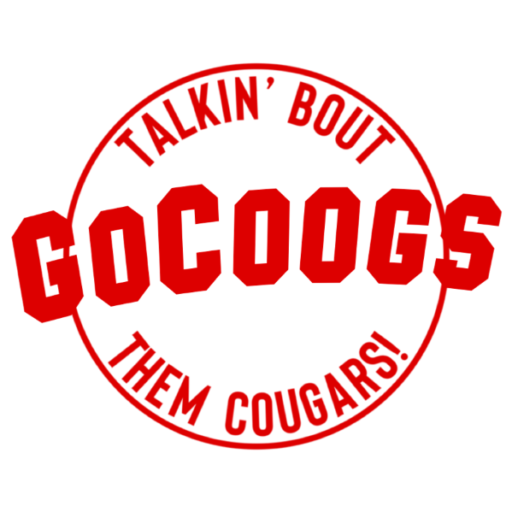On September 2, 1946, the University of Houston football team held their first fall workout in anticipation of the school’s inaugural season. Jewell Wallace, who had won state titles in basketball (El Paso HS 1941) and football (San Angelo 1943), had accepted a $4,500 salary to be the head coach and begin the UH program. He was assisted by two of UH’s other head coaches, Alden Pasche (basketball) and Jack Patterson (track and field).
On that first day of fall camp, 140 men showed up, but only 10 had collegiate football experience. Among them were Jack Gwin, a former UT letterman, and Charlie Manichia, a 25-year-old quarterback who had played on the Aggie freshman team before the war. Manichia had also led Reagan High School to a Houston city championship in 1938. Eight players (and all three coaches) had experience in the Southwest Conference.
By the end of fall camp, 38 players would remain for the UH “A” team, while another 20+ would make up a “B” team that would play a JUCO schedule. 45 players would play on the “A” team throughout the year. Wallace’s team ranged in age from 17-year-old Billy Myers to men as old as 26 (co-captain Tony Ditta and tackle Buck Foss). Ditta and Foss each served four years in the service – Ditta in the Army and Foss in the Air Corps.

The program had started from nothing the spring before. Finding some open fields where the Moody Towers now stand, Wallace, Pasche, and Patterson had to clear the land of rocks and broken glass. In Jerry Wizig’s book Eat Em Up Cougars, Alden Pasche said that “the ground was hard like cement” and was covered with a “black gumbo.”
Growing grass on those fields before fall camp fell to Patterson and Pasche. They spread seeds and watered the field, but when they returned to check on it, “you couldn’t see the field for all the birds on the ground feeding on the seeds.”
The program also had no money for helmets, pads, jerseys, or facilities. Years later, players laughed at how the school handed out pairs of shoes in two different sizes. The equipment manager, Bobby Brown, had to bicycle across town to paint the helmets red. It wasn’t much better for the players, either.
“Civilian clothes were so hard to get right after the war. I wore my uniform for a long time,” Charlie Manichia said. “Like a lot of those guys, I was going to school on the GI Bill. When they asked me about playing football, I figured, `Why not?'”
The 1946 Houstonian Yearbook documented the new team this way:
The University’s practice fields resounded this spring to the dull thuds of footballs being thrown in preparation for the school’s entry into full scale pigskin competition. Under the guidance of Head Coach Jewell Wallace, Line Coach Alden Pasche, assisted by Coach Jack Patterson, the Cougars have gone all out in an attempt to secure for the school its second championship in the Lone Star Conference.

“From nothing, the University was ‘poor boyed’ to its present respectable position. I am now firmly convinced that with proper leadership the University of Houston can achieve recognition as the best school of its type in the nation.
“The University is strong because we had to work and fight to make it what it is.”
– Dr. Walter W. Kemmerer, January 1950
When spring practice began in February 1946, 119 men showed up, and as word spread about UH’s newest team, the number had grown to 153. There were so many players that the coaches had to practice them in two shifts. Wallace trimmed the squad down to 100 by April 1 and asked Rice head coach Jess Neely if they could run plays against the Owls. Wallace had his boys practice a few formations from his T-Formation offense in the days before going to University Boulevard.
When the squad got to Rice, they were stunned by what they saw. Neely had his players in brand new home blue uniforms, the field painted, hired referees, a manned scoreboard, and 20,000 people in the stands. On the other side, UH players showed up wearing their dirty practice uniforms and carrying deflated footballs. This wasn’t two teams practicing together – Neely had set up a full-blown scrimmage.
UH was no competition for Rice that day as the Owls scored 11 touchdowns in a 70-6 blowout. Pasche said it took years for many on that team to live that down. Worse, Neely made sure the scrimmage received plenty of attention in the media, which UH ticket manager Ned Thompson said hurt the school’s first-year ticket sales. Rice would share the Southwest Conference title that year, winning the Orange Bowl over Tennessee and General Robert Neyland.
As UH came back together on September 2, Jewell Wallace had an idea of what he wanted to do with his team in their first season. Lacking size, he wanted to feature fast backs like Gwin and Manichia running the T. More importantly, he knew the type of man he wanted.
“We don’t want any boys who expect to come to the University and do nothing but play football,” Wallace said after that first fall practice. “I am especially interested in returning veterans.
“We started from scratch, and we’re certain to make history.”

